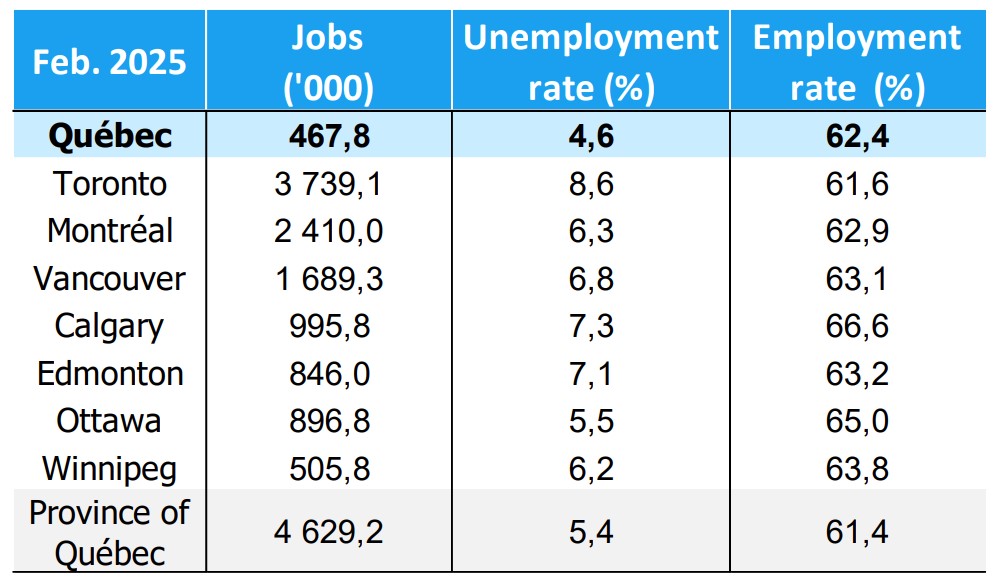Highlights – February 2025

Data visualization
Evolution of the key employment indicators over one year
 Sources: Statistics Canada, Table 14-10-0459-01, and Québec International.
Sources: Statistics Canada, Table 14-10-0459-01, and Québec International.
Overview of employment in major Canadian regions

Analysis
Contraction of employment and the unemployment rate in Québec City
According to the Labour Force Survey (LFS) conducted by Statistics Canada, the labour market continued its downward trend in February, registering a loss of 3,800 jobs (-0.8%). Other indicators also decreased during that period, with the labour force dropping from 494,800 to 490,100 people (-0.9%), and the employment rate falling by 0.6 percentage points (pp). The drop in the labour force, higher than in employment, led to a slight decrease in the unemployment rate (-0.1 pp).
Across Canada, the labour market fluctuated slightly in February. However, these variations are opposite to those registered in the Québec City CMA. The region’s unemployment rate remains the lowest across all eight major Canadian CMAs, a situation that could be explained in part by the shrinking of the labour force. In the province of Quebec, the employment rate increased slightly (+0.1 pp), while the unemployment rate remained stable.
Significant decrease over one year
Over a period of one year, the CMA registered one of the lowest performances in terms of employment, with a drop of 3.0%, placing Québec City in fifth position among all Canadian CMAs. This situation could in part be attributed to a significant decrease in the labour force (-1.5%) over the same period.
Customs tariffs: Uncertainty for manufacturers
It is still too soon to measure the impact of trade uncertainty on the employment dynamics in the Québec City CMA. A trade war represents a real and significant threat for the region’s economy and labour market, as the latter was already showing signs of a slowdown.
Manufacturing industries are highly exposed to the American market due to their high volume of export. In February 2025, non-seasonally adjusted data showed that the manufacturing sector accounts for 7.5% of employment in the CMA. This represents an increase of 1.4% over 12 months in the number of jobs that are exposed to the uncertainty surrounding customs tariffs.
To this day, many variables are still unknown surrounding the delay granted on goods covered under the Canada-United States-Mexico Agreement (CUSMA). Regarding the uncertainty, its impact is already noticeable, as it is likely to influence businesses’ development prospects. For the labour market, these uncertainties, as well as other factors, will have an impact on employment stability throughout the year.
Rosalie Forgues
Economist
Québec International




